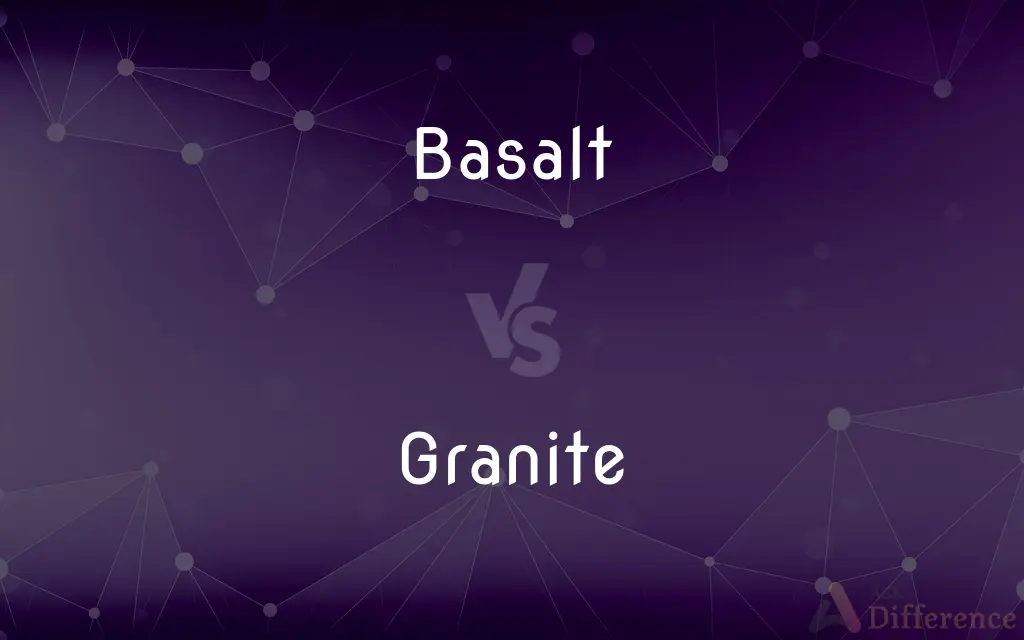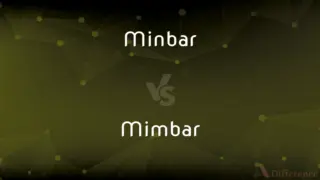Basalt vs. Granite — What's the Difference?
By Tayyaba Rehman & Fiza Rafique — Updated on April 15, 2024
Basalt is a dense, dark volcanic rock, primarily formed from rapid cooling of lava, while granite is a lighter, coarse-grained igneous rock formed slowly from cooled magma.

Difference Between Basalt and Granite
Table of Contents
ADVERTISEMENT
Key Differences
Basalt is typically dark in color, consisting of mainly fine grains, which results from the rapid cooling of lava at or near the Earth's surface. Whereas granite, with its lighter hues, often displays a coarse-grained texture because its crystals had more time to form as the magma cooled slowly underground.
Basalt is primarily composed of plagioclase and pyroxene, making it rich in iron and magnesium. On the other hand, granite is mainly made up of quartz and feldspar, which gives it a higher silica content and makes it less dense than basalt.
Basalt forms the ocean floors and is the most abundant bedrock found in the outer layers of Earth due to its origin from widespread volcanic activity. Conversely, granite is commonly found in the Earth's continental crust, forming mountains and other large land structures.
The cooling process of basalt leads to its fine-grained texture, which facilitates a relatively uniform mineral distribution. Granite, however, cools more slowly, allowing for the growth of larger and more distinct crystal grains that contribute to its varied texture and appearance.
Basalt is generally more durable and has higher compressive strength, making it suitable for construction bases and roadstones. Granite, while also durable, is more often used aesthetically in countertops and as decorative stone due to its varied and appealing appearance.
ADVERTISEMENT
Comparison Chart
Color
Dark (black, gray)
Lighter (white, pink, gray)
Texture
Fine-grained
Coarse-grained
Composition
Plagioclase, pyroxene
Quartz, feldspar
Density
Higher, more compact
Lower, less dense
Common Uses
Construction base, roadstone
Countertops, decorative stone
Compare with Definitions
Basalt
Composed mainly of plagioclase and pyroxene.
The basalt sample contained noticeable amounts of pyroxene.
Granite
A coarse-grained igneous rock primarily made of quartz and feldspar.
The kitchen countertops are crafted from polished granite.
Basalt
Dark, fine-grained volcanic rock.
The ancient city was built on a foundation of basalt.
Granite
Forms from slow cooling of magma underground.
The granite ridge represents millions of years of geological evolution.
Basalt
Commonly found in oceanic crust.
Ocean drilling projects frequently encounter layers of basalt.
Granite
Predominantly found in the continental crust.
The mountain range is composed largely of granite.
Basalt
Used in heavy construction and paving.
The new road uses crushed basalt as a base layer.
Granite
Often appears in lighter shades with visible grains.
The granite boulder stood out with its pinkish hue and speckled pattern.
Basalt
Forms from rapid cooling of lava.
Basalt columns in the valley were formed from rapidly cooled lava.
Granite
Popular for aesthetic architectural and decorative uses.
The lobby features walls lined with ornate granite panels.
Basalt
Basalt (US: , UK: ) is a fine-grained extrusive igneous rock formed from the rapid cooling of low-viscosity lava rich in magnesium and iron (mafic lava) exposed at or very near the surface of a rocky planet or a moon. More than 90% of all volcanic rock on Earth is basalt.
Granite
Granite () is a coarse-grained igneous rock composed mostly of quartz, alkali feldspar, and plagioclase. It forms from magma with a high content of silica and alkali metal oxides that slowly cools and solidifies underground.
Basalt
A hard, dense, dark igneous rock composed chiefly of plagioclase feldspar, pyroxene, and olivine, and often having a glassy appearance.
Granite
A common, coarse-grained, light-colored, hard igneous rock consisting chiefly of quartz, orthoclase or microcline, and mica, used in monuments and for building.
Basalt
A kind of hard unglazed pottery.
Granite
Unyielding endurance; steadfastness
A will of granite.
Basalt
(mineral) A hard mafic igneous rock of varied mineral content; volcanic in origin, which makes up much of the Earth's oceanic crust.
Granite
(rock) A group of igneous and plutonic rocks composed primarily of feldspar and quartz. Usually contains one or more dark minerals, which may be mica, pyroxene, or amphibole. Granite is quarried for building stone, road gravel, decorative stone, and tombstones. Common colors are gray, white, pink, and yellow-brown.
Basalt
A type of unglazed pottery.
Granite
Toughness; the quality of having a thick skin or being rough.
Basalt
A rock of igneous origin, consisting of augite and triclinic feldspar, with grains of magnetic or titanic iron, and also bottle-green particles of olivine frequently disseminated.
Granite
A crystalline, granular rock, consisting of quartz, feldspar, and mica, and usually of a whitish, grayish, or flesh-red color. It differs from gneiss in not having the mica in planes, and therefore in being destitute of a schistose structure.
Basalt
An imitation, in pottery, of natural basalt; a kind of black porcelain.
Granite
Plutonic igneous rock having visibly crystalline texture; generally composed of feldspar and mica and quartz
Basalt
The commonest type of solidified lava; a dense dark gray fine-grained igneous rock composed chiefly of calcium-rich plagioclase feldspar and pyroxene
Granite
Something having the quality of granite (unyielding firmness);
A man of granite
Common Curiosities
What is basalt?
Basalt is a dark, fine-grained volcanic rock primarily formed from the rapid cooling of lava.
How do the textures of basalt and granite differ?
Basalt has a fine-grained texture due to rapid cooling, while granite has a coarse-grained texture from slow cooling.
Where is granite typically found?
Granite is mainly found in the continental crust, particularly in mountainous regions.
What is granite?
Granite is a coarse-grained igneous rock formed slowly from magma that cools underground.
What minerals are predominantly found in basalt?
Basalt primarily contains plagioclase and pyroxene.
What minerals are predominantly found in granite?
Granite is mainly composed of quartz and feldspar.
Is granite used in heavy construction?
While granite can be used in construction, it is more valued for its aesthetic appeal in architectural elements.
What color is basalt?
Basalt is generally dark, typically black or dark gray.
Where is basalt typically found?
Basalt is typically found in ocean floors and other areas with frequent volcanic activity.
Which rock has a higher silica content, basalt or granite?
Granite has a higher silica content compared to basalt.
What are the main uses of basalt?
Basalt is widely used as a base in construction and roadstone due to its durability.
What are the main uses of granite?
Granite is popular for aesthetic uses such as in countertops and decorative stone due to its beauty.
Which rock is denser, basalt or granite?
Basalt is denser and more compact than granite.
Can basalt appear above ground?
Yes, basalt can appear above ground, typically in areas of past volcanic activity.
What color is granite?
Granite varies in color but often appears in lighter shades such as white, pink, or light gray.
Share Your Discovery

Previous Comparison
Minbar vs. Mimbar
Next Comparison
Questionnaire vs. ScheduleAuthor Spotlight
Written by
Tayyaba RehmanTayyaba Rehman is a distinguished writer, currently serving as a primary contributor to askdifference.com. As a researcher in semantics and etymology, Tayyaba's passion for the complexity of languages and their distinctions has found a perfect home on the platform. Tayyaba delves into the intricacies of language, distinguishing between commonly confused words and phrases, thereby providing clarity for readers worldwide.
Co-written by
Fiza RafiqueFiza Rafique is a skilled content writer at AskDifference.com, where she meticulously refines and enhances written pieces. Drawing from her vast editorial expertise, Fiza ensures clarity, accuracy, and precision in every article. Passionate about language, she continually seeks to elevate the quality of content for readers worldwide.
















































